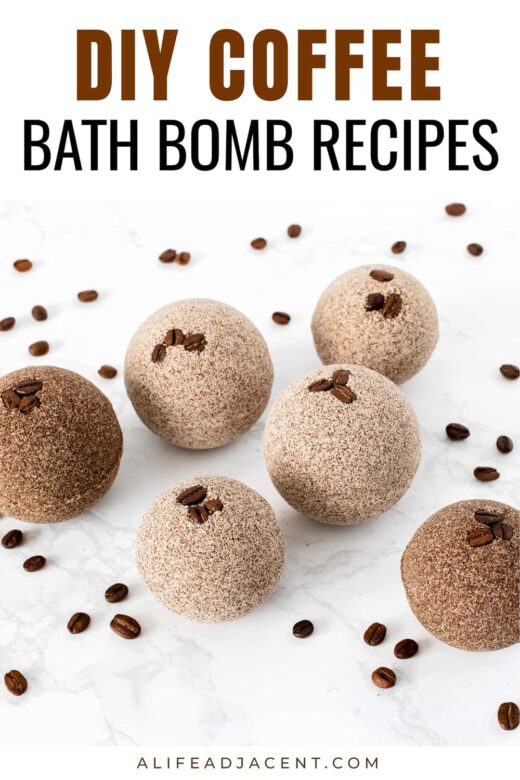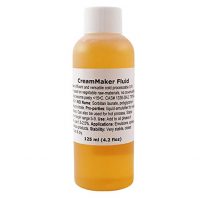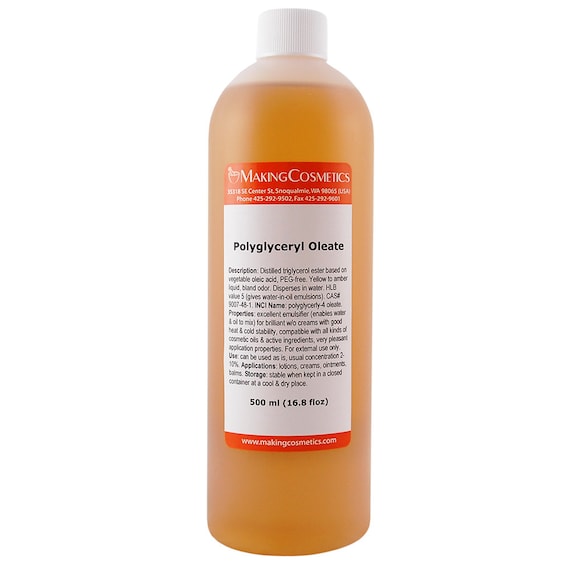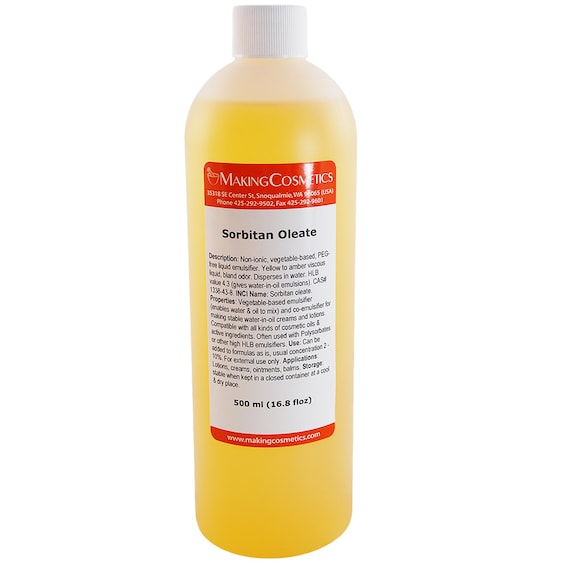Learn how to make coffee bath bombs! Turn your bathwater into a frothy, skin-softening latte with this fragrant bath bomb recipe. These no-fail DIY coffee bath bombs are easy to make, and they have a rich and decadent aroma that’s sure to please coffee connoisseurs.
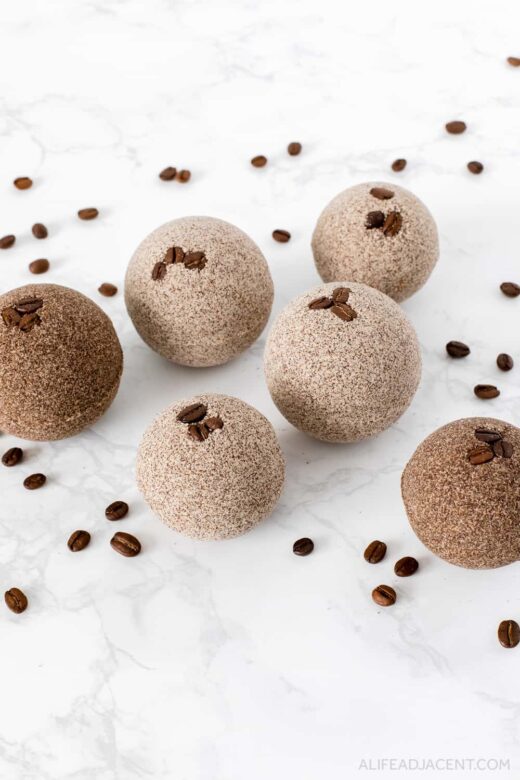
I’m the kind of person that always looks forward to my morning coffee. So you can trust me when I say that if you’re a coffee lover, this is the bath bomb recipe for you.
With natural ingredients like milk powder and instant coffee, these coffee bath bombs are the closest you can get to bathing in your latte.
Aside from real coffee, they also contain coffee essential oil for antioxidant benefits and an extra punch of potent coffee fragrance.
Read on to learn how to make several varieties: latte bath bombs, espresso bath bombs, coffee and cream bath bombs, as well as a coconut milk option for vegans.
For the perfect pairing to your bath bombs, also check out my coffee body scrub recipes based on popular coffee drink flavours.
- Tips for making the best coffee bath bombs
- Coffee bath bombs recipe ingredients
- DIY Coffee Bath Bombs Recipes
- How to make coffee bath bombs
- The best essential oils for coffee bath bombs
- Coffee bath bomb essential oil blends
- DIY coffee bath bomb FAQ
- Do bath bombs need emulsifiers?
- How long does it take for bath bombs to dry?
- Can you make bath bombs in high humidity?
- Can you use coffee grounds in bath bombs?
- What liquid should I use for bath bombs?
- How long do bath bombs last?
- How do you package bath bombs?
- How do you avoid flat bottoms when making bath bombs?
Tips for making the best coffee bath bombs
I tweaked these coffee bath bombs several times to come up with a recipe that worked consistently.
So, I also wanted to outline some of the issues I encountered while making these bath bombs and how I fixed them. I hope to help you avoid the same mistakes, and my goal is to make the process as easy as possible.
Be sure to read the FAQ section at the bottom of this post for tips on making the best DIY coffee bath bombs, tricks, and troubleshooting.
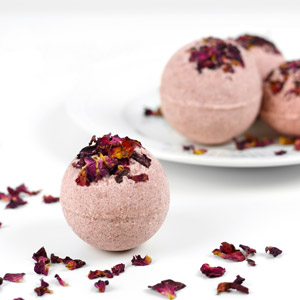
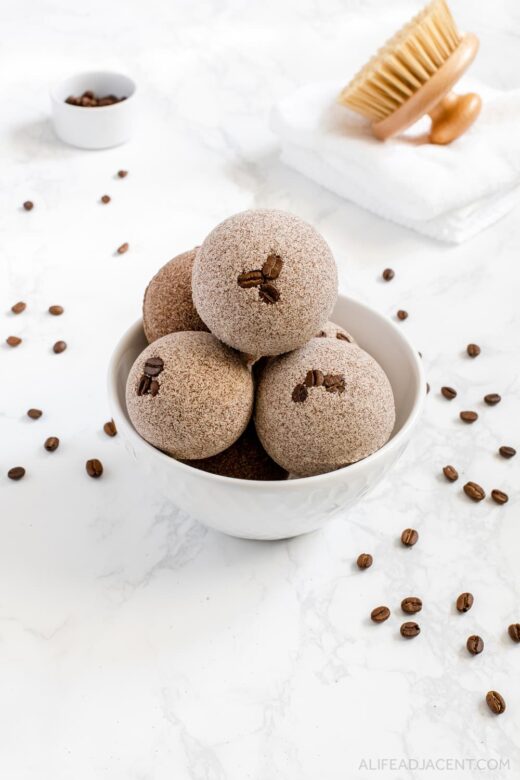
Coffee bath bombs recipe ingredients
Baking soda and citric acid
Like most bath bomb recipes, these coffee bath bombs are made with a base of baking soda and citric acid. These ingredients create the fizzing reaction that puts the “fizzy” in bath fizzies.
Baking soda and citric acid also hold and disperse the liquid bath bomb ingredients, such as the essential oils, carrier oils, and emulsifier.
Baking soda and citric acid are also the main ingredients in shower bombs, otherwise known as shower steamers.
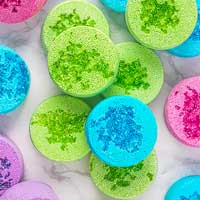
Instant coffee powder
The best way to make coffee scented bath bombs is with real coffee! And organic instant coffee powder is the secret ingredient.
Powdered coffee dissolves when it contacts your bathwater, releasing a potent and decadent coffee fragrance – not to mention a variety of skin benefits as well.
Coffee is chock full of antioxidants for healthy skin, and its high caffeine content has even been associated with an improvement in the appearance of cellulite. Caffeine is also a potent antioxidant in itself and is reported to help protect skin from UV damage.
Of course, coffee bath bombs are not a substitute for any aesthetic treatments. But at the very least, bathing in coffee just might help you achieve more radiant skin.
Tip: if you can’t find coffee powder, you can run freeze dried instant coffee granules though a coffee or spice grinder to make your own coffee powder.
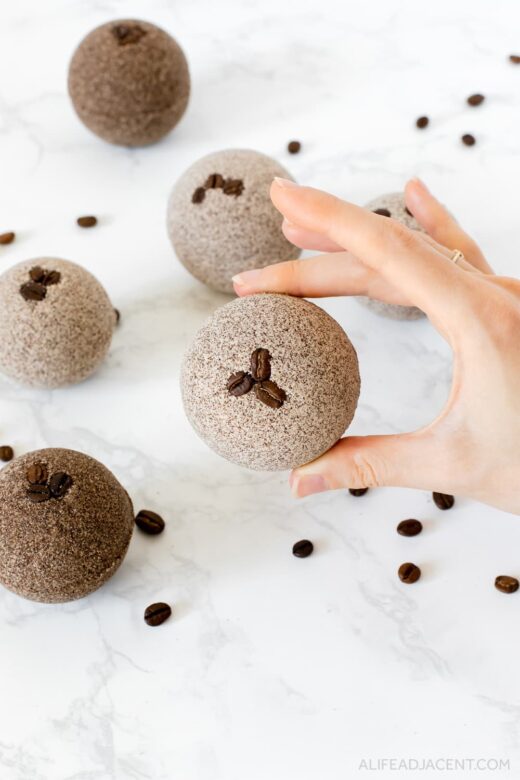
Milk powder
You can’t have a latte without milk, so milk powder is a must for these DIY coffee bath bombs. Using milk powder also allows you to make bath bombs without corn starch.
There’s a reason why milk baths are recommended for dry skin. Milk powder is rich in skin-softening proteins and fatty acids which nourish the skin. It also imparts a silky feel to bathwater.
But it also serves another purpose: milk powder also helps create froth during the fizzing reaction. So you’ll find that as your bath bomb fizzes, it creates what looks like real latte foam in your bathwater.
You can use any kind of powdered milk for bath bombs. Non-fat dry milk works well for latte bath bombs. But you can also use full-fat milk powder for coffee and cream bath bombs. Like cream in your coffee, whole milk powder adds a dose of nourishing fatty acids to your bathwater.
Of course, if black coffee is your drink of choice, you can leave out the milk powder entirely to make espresso bath bombs that smell just like your favourite dark roast.
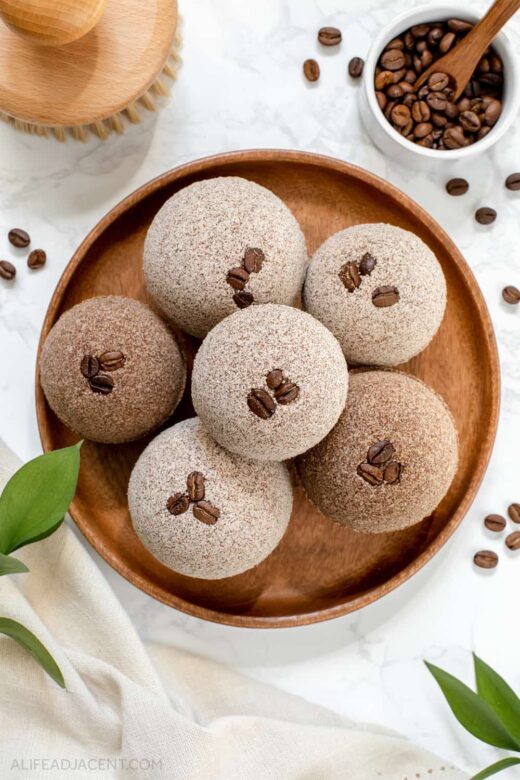
Is there an alternative to milk powder in bath bombs?
Yes, those who are vegan or dairy free are in luck, because coconut milk powder can be used as a substitute for milk powder in this recipe.
Much like milk powder, powdered coconut milk is rich in saturated fats that help nourish the skin. And its creamy, coconut scent creates bath bombs that smell like a delicious coconut milk latte.
By the way, our coconut coffee body scrub would make the perfect pairing to these bath bombs.
Natural emulsifier for bath bombs
I wanted to make these bath bombs without polysorbate 80, which is the most typically used bath bomb emulsifier.
While controversial, there are safety concerns with polysorbate 80 being an ethoxylated ingredient and possibly containing chemical residue as a result.
So, what can replace polysorbate 80 in bath bombs? When it comes to natural liquid emulsifiers, I have found that CreamMaker FLUID, polyglyceryl oleate, and sorbitan oleate are the closest natural alternatives to polysorbate 80.
They all work well, so you can use them interchangeably depending on what’s available to you.

However, the downside is that natural bath bomb emulsifiers are not always the most inexpensive or easily available. So if polysorbate 80 is more accessible, it may be the best choice for you.
If you’re wondering whether you can safely skip the emulsifier, the answer is no. For more information on why bath bombs need emulsifiers, see the FAQ section.
Note: in Europe, polyglyceryl oleate is also known under the name Durosoft PG4-0 or Durosoft SF.
Coconut oil
Using oil in bath bombs helps dilute your essential oils and provide extra skin-softening benefits.
I used a very small amount of fractionated coconut oil in these coffee bath bombs. A small amount is key, as too much oil can cause bath bombs to become too soft.
If you don’t have liquid coconut oil, you can also melt regular solid coconut oil in the microwave. Saturated oils like coconut oil are ideal for bath bombs as they have the longest shelf lives. Saturated fatty acids are also very stable and won’t oxidize in hot bathwater.
Coffee essential oil
Your bath bombs will already have a rich coffee scent from the instant coffee powder. But infusing them with coffee essential oil makes the fragrance even stronger, and helps take your bath bombs’ scent to the next level of decadence.
If you’ve never smelled coffee essential oil, it’s smells like a shot of rich espresso. And if you’re a coffee lover, you’re going to want to get your hands on some immediately.
Aside from its energizing coffee aroma, it’s also rich in skin benefits. Coffee oil is mechanically separated from coffee beans, so it has many of the same antioxidants and other beneficial compounds found in coffee beans, including a very small amount of caffeine.
But you aren’t limited to plain coffee – see the essential oil blends section for more ideas, including vanilla latte bath bombs.
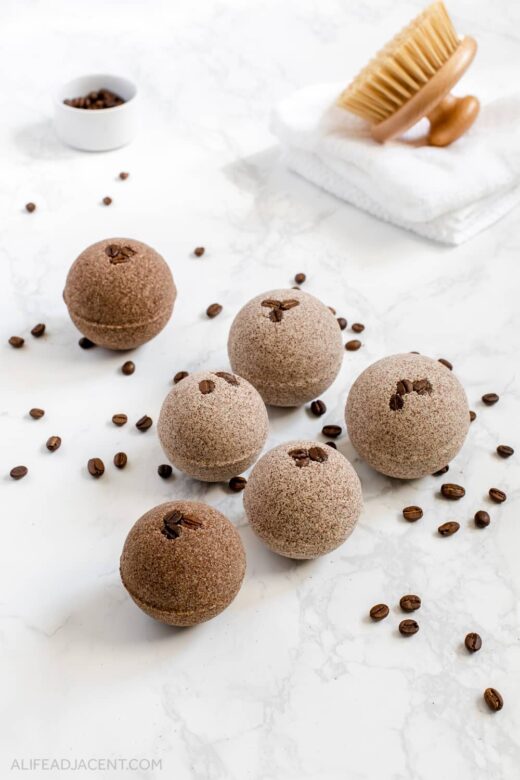
Alcohol
Lastly, you will also need a spray bottle filled with alcohol to moisten your coffee bath bomb mixture.
Adding a small amount alcohol ensures the mixture sticks together. The excess moisture evaporates, leaving behind a hardened bath bomb.
For more information on why alcohol is the best liquid for bath bombs, see the FAQ section.
Equipment for making coffee bath bombs
Aside from your DIY bath bomb ingredients, you will also need the following equipment:
- Coffee beans for garnishing. While optional, a few coffee beans make a nice garnish on the top of your bath bombs.
- Bath bomb molds. I like stainless steel bath bomb molds as they’re more durable than plastic or aluminum molds.
- Glass lab beaker. A small beaker is useful for for mixing your oil-based ingredients, and the millilitre markings on the side make measuring easy. However, you can also use any small container.
- Mixing bowl. You will need a large mixing bowl to mix your bath bomb ingredients.
- Nitrile gloves. Gloves protect your hands while kneading the mixture, as citric acid is corrosive and may irritate your skin.
- Sieve. Sifting your ingredients is vital to ensure you do not end up with lumpy bath bombs.
- Mineral oil (baby oil) for greasing. No, it’s not natural, but using a small amount of mineral oil is the best way to ensure your bath bombs don’t stick to the molds!

DIY Coffee Bath Bombs Recipes
Latte Bath Bombs
1 cup + 2 tbsp baking soda
1/2 cup + 1 tbsp citric acid
1/4 cup + 0.5 tbsp milk powder
1/2 cup + 2 tbsp instant coffee powder
4 tsp / 20ml fractionated coconut oil
2 tsp / 10 ml emulsifier (polyglyceryl oleate, sorbitan oleate or CreamMaker FLUID)
50 drops coffee essential oil
Alcohol to moisten mixture
Coffee Bath Bombs
1 cup + 2 tbsp baking soda
1/3 cup + 1 tbsp citric acid
3/4 cup + 2.5 tbsp instant coffee powder
4 tsp / 20ml fractionated coconut oil
2 tsp / 10 ml emulsifier
50 drops coffee essential oil
Alcohol to moisten mixture
Coffee and Cream Bath Bombs
1 cup + 2 tbsp baking soda
1/2 cup + 1 tbsp citric acid
1/4 cup + 0.5 tbsp whole milk powder
1/2 cup + 2 tbsp instant coffee powder
4 tsp / 20ml fractionated coconut oil
2 tsp / 10 ml emulsifier
50 drops coffee essential oil
Alcohol to moisten mixture
Coconut Milk Latte Bath Bombs
1 cup + 2 tbsp baking soda
1/2 cup + 1 tbsp citric acid
1/4 cup + 0.5 tbsp coconut milk powder
1/2 cup + 2 tbsp instant coffee powder
4 tsp / 20ml fractionated coconut oil
2 tsp / 10 ml emulsifier
50 drops coffee essential oil
Alcohol to moisten mixture
How to make coffee bath bombs
- Before you begin, prepare your bath bomb molds. Grease the inside of each mold with a small amount of mineral oil to ensure your bath bombs are easy to remove. Arrange your coffee bean garnish as desired in one side of the mold.
- Using a sieve, sift all dry bath bomb ingredients into a large bowl. This is important to ensure a uniform texture. If you don’t sift, your coffee bath bomb mixture will end up lumpy and uneven.
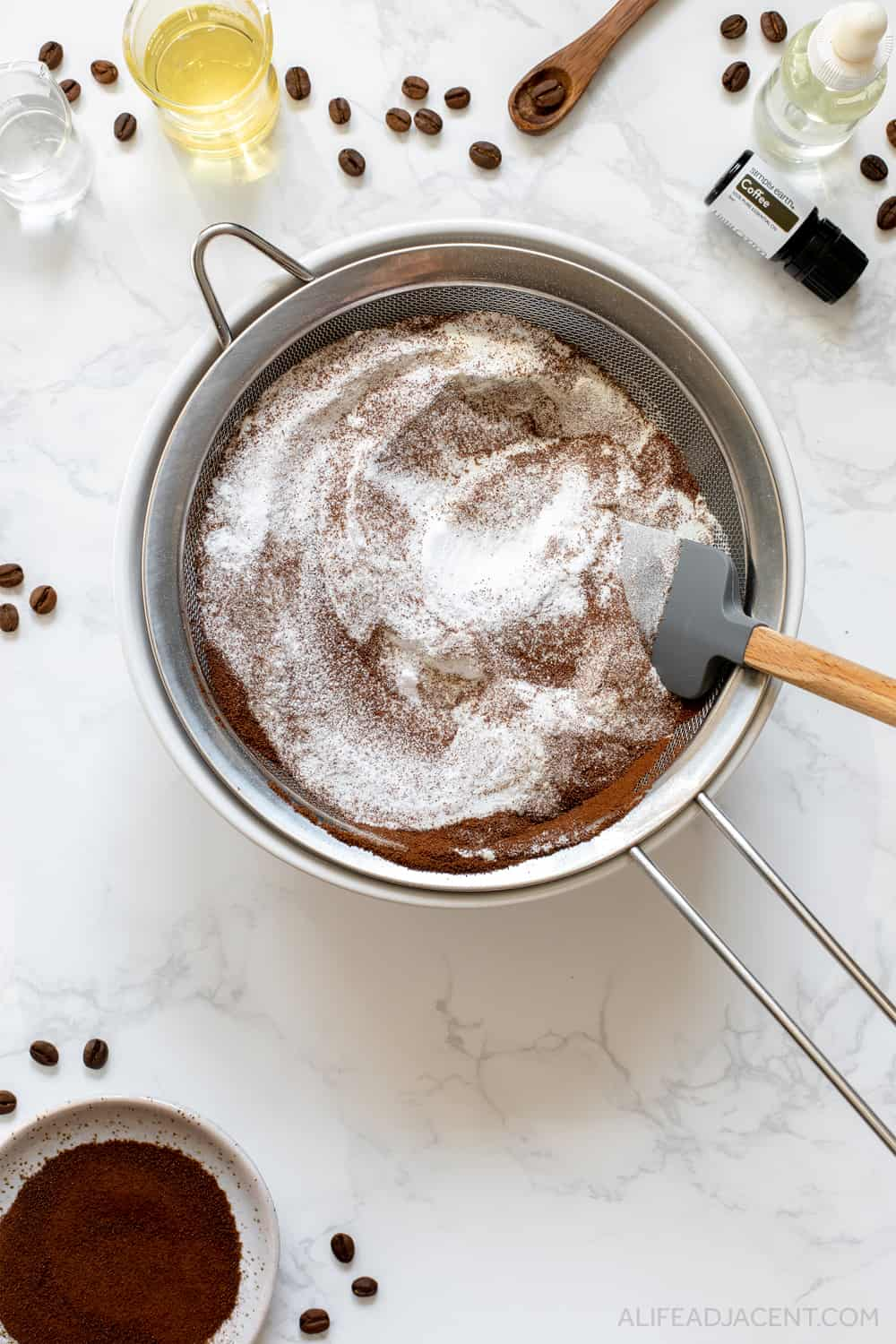
- Once the dry ingredients are sifted, mix well with a wooden spoon or spatula to ensure everything is evenly incorporated.
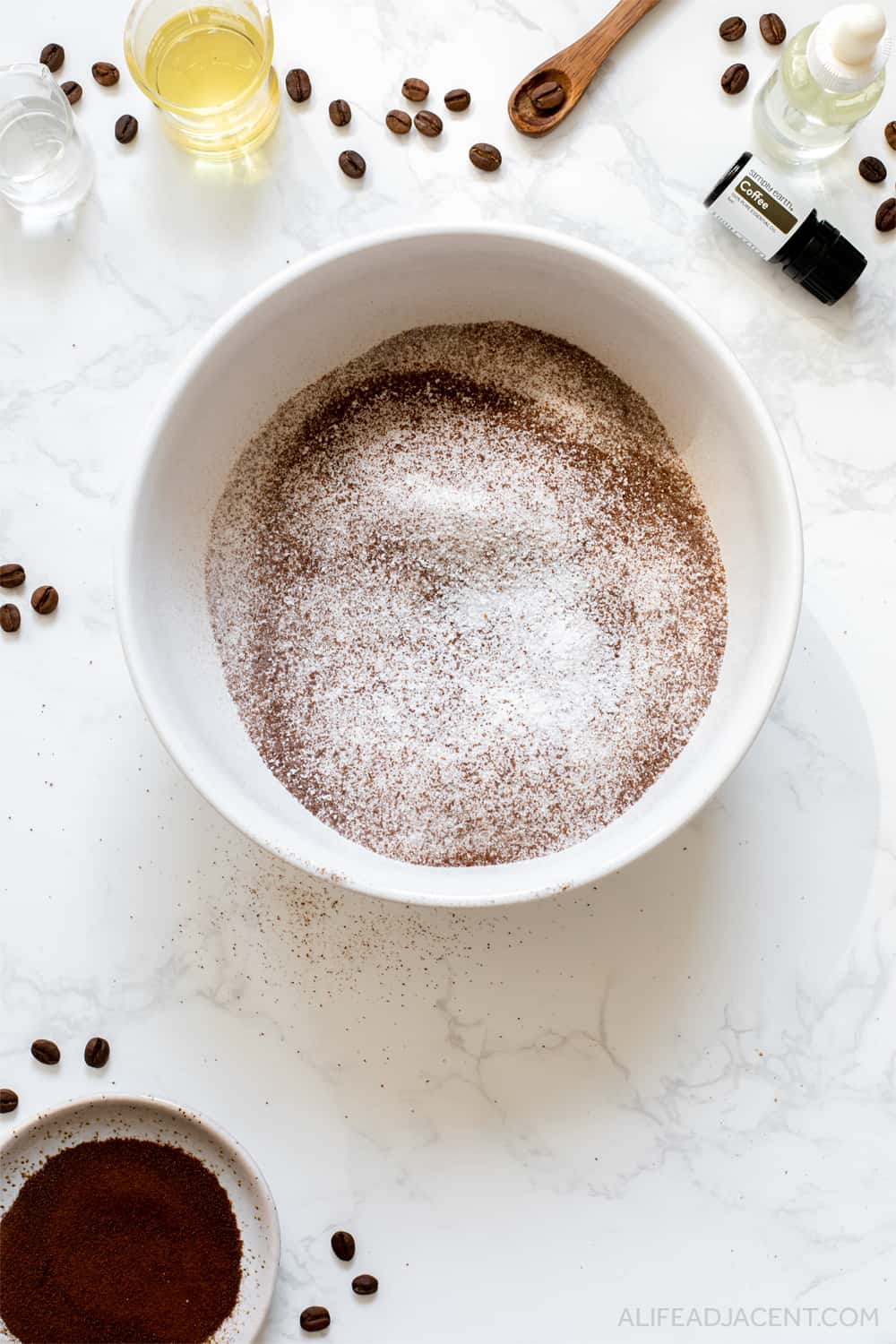
- In a small container (such as a glass lab beaker), combine all oil-based bath bomb ingredients: coconut oil (or liquid carrier oil of choice), liquid bath bomb emulsifier, and coffee essential oil.
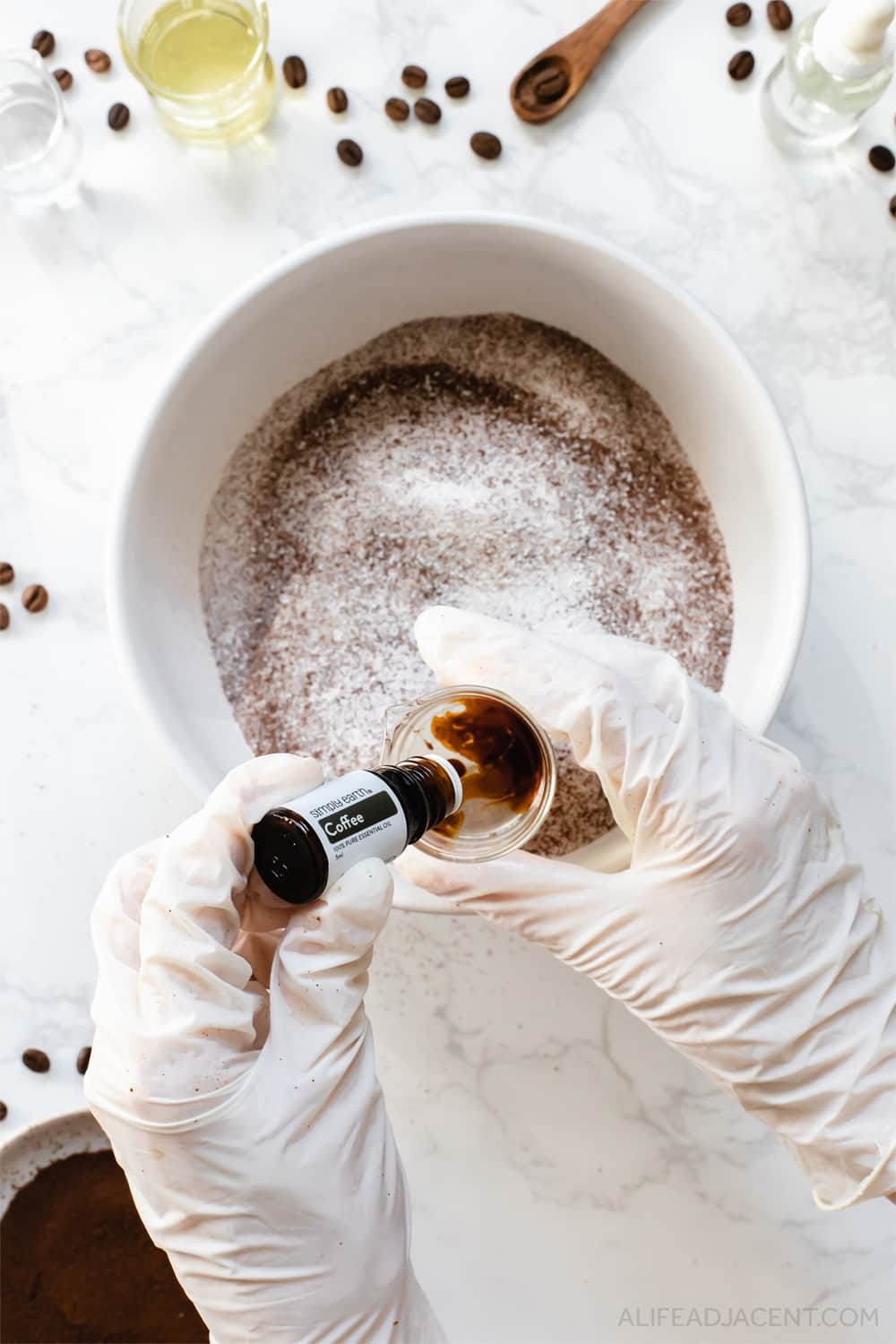
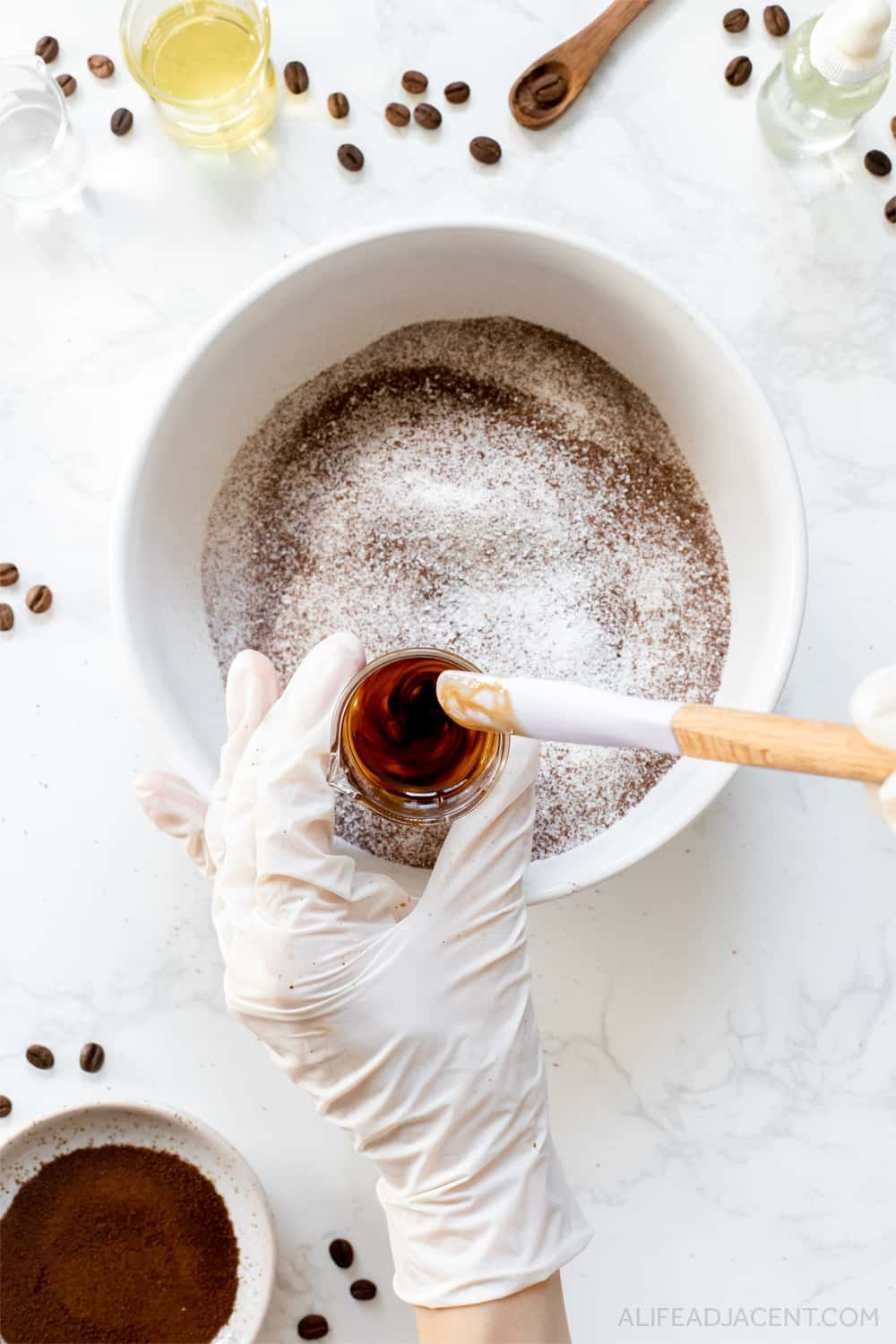
- Once you’ve mixed your oil-based ingredients together, pour them into the dry ingredients.

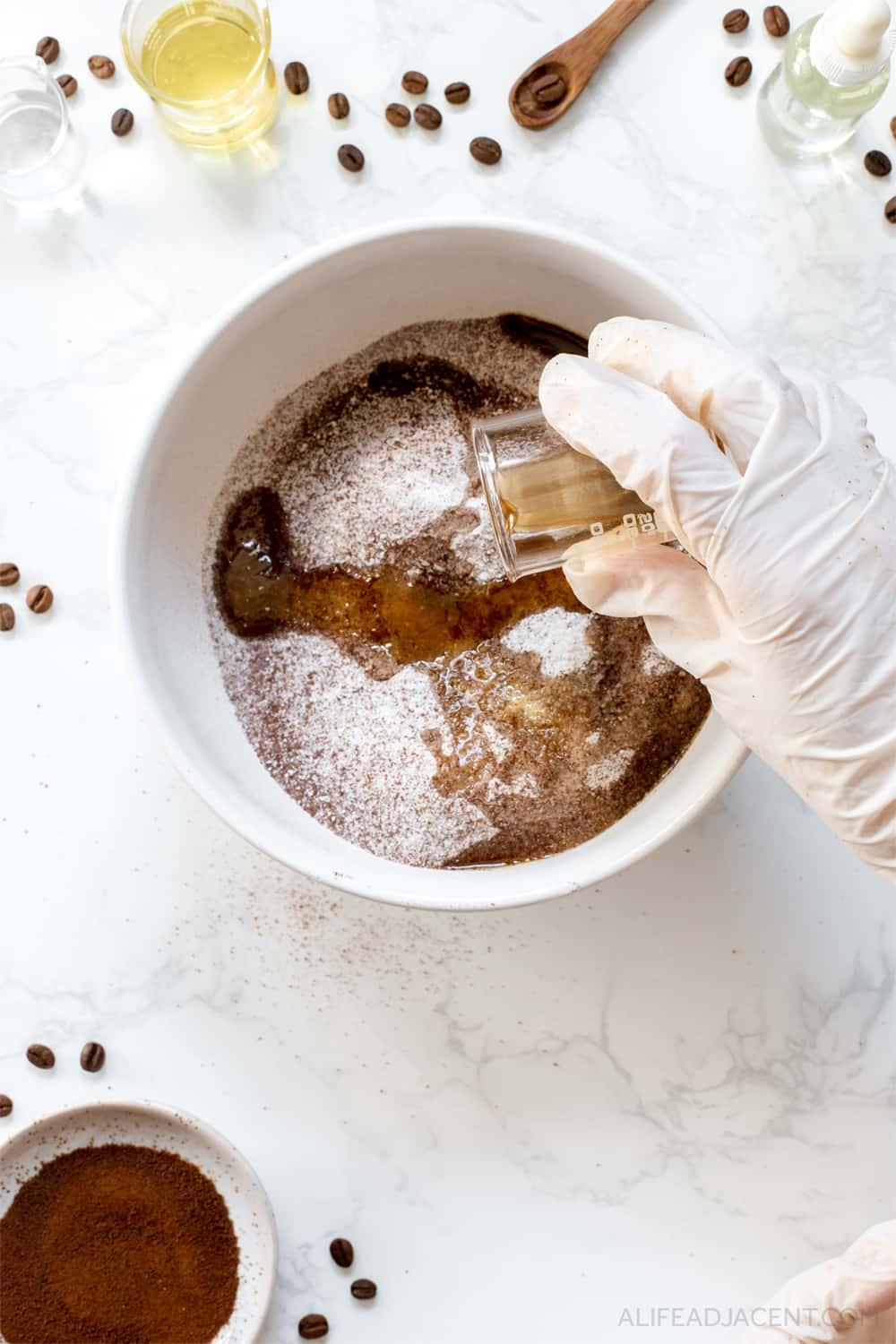
- Put on your gloves. Using your hands, knead the oil into the coffee bath bombs mixture. Using your hands is the best way to ensure the oils are evenly incorporated into the dry ingredients. Knead until the mixture has a uniform texture and the consistency of slightly damp sand. Be sure to remove all lumps as these will affect the look of your bath bombs.

- At this point the mixture will begin to stick, but we still need to add a bit of moisture to fully bind it together. Spritz a few sprays of alcohol into the bath bomb mixture. Knead to incorporate. Start slowly here, as you want to add just enough to help the mixture stick together, but not so much that it becomes soggy. One way to determine whether it’s ready it’s to squeeze it together in your hand until it sticks together, then drop it back into the bowl. If it holds its shape and didn’t crumble apart, it’s likely ready to mold.

- Take the garnished half of your bath bomb mold and carefully pack the mixture over top. Be careful not to disturb your garnish. The mold will be slippery from the mineral oil, so the coffee beans will be prone to sliding. Once you’ve secured the coffee beans in place, you can pack the rest of the mold.
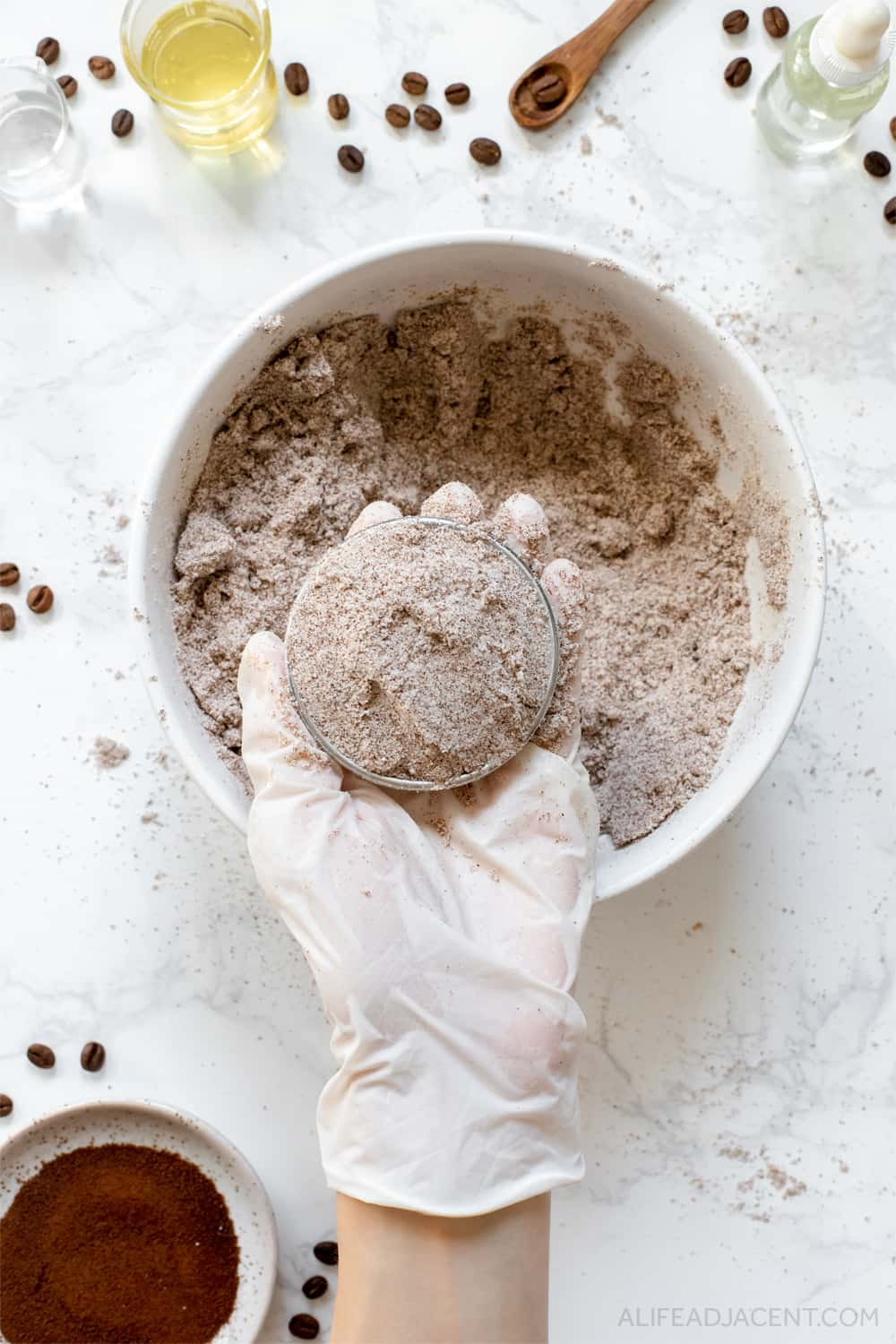
- Once you’ve packed the garnished bath bomb mold, loosely fill the other half of the mold until it overflows. Don’t pack or press the bath bomb mixture too tightly – filling loosely is key, as this allows any excess to easily fall away.
- Then, press the molds together firmly until the excess mixture falls away and the two halves make contact. Run your fingers around the edge of the mold to remove any overflow. Then, place aside while you mold the rest of the coffee bath bombs.
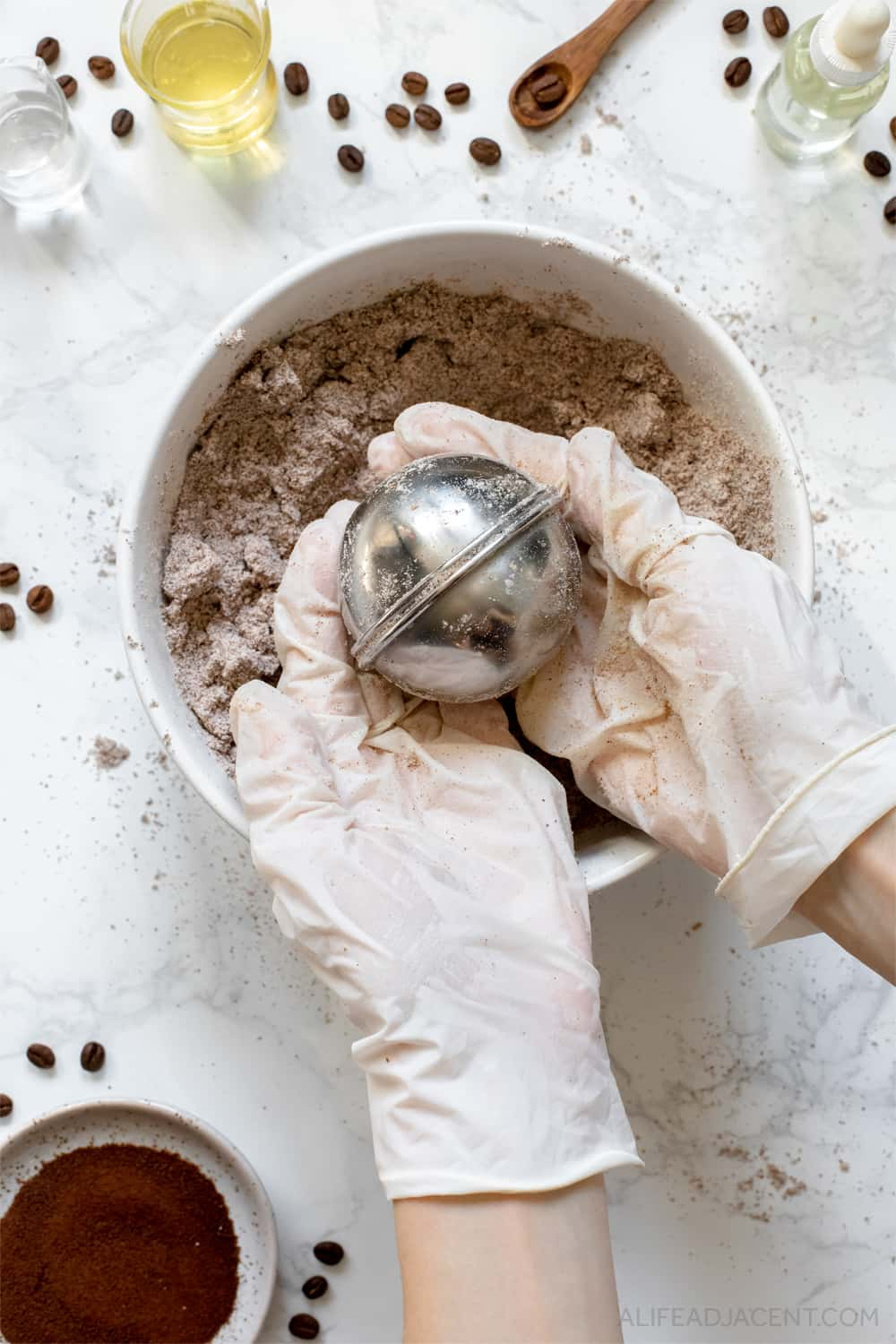
- Leave the bath bombs in their molds for approximately 20 minutes to allow them to take shape. Later, you will carefully release the bath bombs from their mold, and place them back into the bottom half to dry completely.
- By now the bath bombs should be hardened enough to be gently handled. Very carefully release each bath bomb from the mold, one half at a time, before placing each side of the bath bomb gently back into the mold again. Do not remove the bath bombs from the molds completely yet. The point of this step is to loosen the molds and ensure the bath bombs are not stuck. You may need to twist gently or even hit the molds against a countertop to fully loosen each bath bomb. Thanks to the mineral oil, it shouldn’t take much effort to unstick them.
- Once you’ve released each bath bomb, remove the top half of the mold. Gently place the bath bombs to dry in the bottom half. This ensures they dry out thoroughly while avoiding flat bottoms. Leave them in an area where they will not be disturbed for at least 24 hours. For tips on drying bath bombs, especially in high humidity, see the FAQ section.
- Once your DIY bath bombs are completely dry, wrap them in plastic wrap to protect them from absorbing any moisture. Store in a cool, dry place.
The best essential oils for coffee bath bombs
We used the high-quality, cold-pressed coffee essential oil that came with the September 2021 Simply Earth Essential Oil Recipe Box.
The September box includes 4 full-size essential oils that can be used for bath bombs or any other essential oil recipes:
- Coffee essential oil
- Blood orange essential oil
- Cinnamon leaf essential oil
- Sweet Dreams essential oil blend
Aside from the oils, the box includes 6 original recipes and the supplies to make each one. You can see the full box contents here.
For more information, check our our full, in-depth Simply Earth essential oils review.
If you’d like to give the Simply Earth box a try, new subscribers get a free Bonus Box. You can also use our code ALIFEADJACENTFREE to get a $40 gift card with your box.
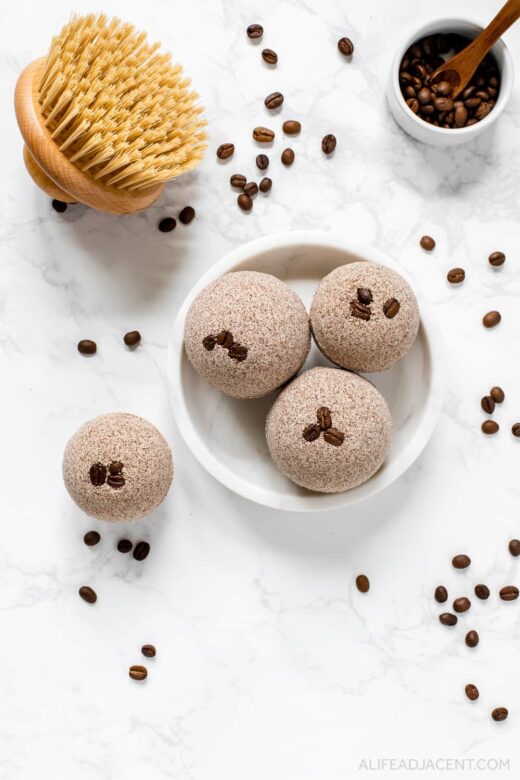
Coffee bath bomb essential oil blends
You aren’t limited to plain coffee! Choose between several essential oil blend ideas for your DIY coffee bath bombs:
- Espresso Bath Bombs: 50 drops coffee essential oil
- Vanilla Latte Bath Bombs: 20 drops coffee essential oil + 30 drops vanilla oleoresin
- Caramel Macchiato Bath Bombs: 20 drops coffee essential oil + 30 drops tonka bean absolute
- Mocha Bath Bombs: 20 drops coffee essential oil + 30 drops chocolate absolute

DIY coffee bath bomb FAQ
Do bath bombs need emulsifiers?
Emulsifiers are an important yet frequently overlooked ingredient in DIY bath bombs. The bath bomb professionals use them, but they’re often omitted from homemade bath bomb recipes.
I understand wanting to make simple, natural bath bombs at home without unnecessary ingredients. But using an emulsifier doesn’t have to be complicated, and not all emulsifiers are toxic.
Emulsifiers are important to ensure the carrier oils and essential oils in your coffee bath bombs disperse into your bathwater instead of floating on top.
Not only are oil slicks unsightly, but they’re also a safety issue. Puddles of coconut oil make for a slippery tub. And pockets of undiluted essential oils can cause irritation and even skin burns.
So, this is why using an emulsifier is an important part of using essential oils in the bath safely. For more information, see this article.

How long does it take for bath bombs to dry?
Your coffee bath bombs should be dry to the touch after being left out overnight. However, many bath bomb experts caution that they are not fully dry until after 24 hours, so you shouldn’t wrap or package them until the full time has elapsed.
Can you make bath bombs in high humidity?
Yes. While a lower humidity environment is ideal, it’s still possible to make bath bombs in high humidity.
These coffee bath bombs contain ingredients that absorb a lot of moisture from the air, such as milk powder and instant coffee. However, using a few tips, I have still managed to make good bath bombs in our high humidity home.
According to my Laser Egg air quality monitor, our home’s humidity level is frequently between 52-56%.

Tips for making bath bombs in high humidity:
- Use alcohol. This one is important – when it comes to making bath bombs, alcohol is best in high humidity, as it evaporates quickly. Avoid using water or witch hazel in your bath bomb mixture.
- Use a dehumidifier. If you have a one, this is ideal. Simply set it up your dehumidifier in the room where you’ll be drying your bath bombs. But I didn’t use one, so it’s not a necessity.
- Set up a fan. Instead of using a dehumidifier, I set up a fan to point directly at my bath bombs while they dried. For best results, turn the bath bombs every few hours for even drying.
- Use a closed container. You can also use a closed container such as a plastic tote bin to create a low-moisture environment to dry your bath bombs. Fill the tote with rice to absorb water, place the bath bombs inside and close the lid.
Can you use coffee grounds in bath bombs?
No, please note that coffee grounds are not a substitute for instant coffee in this bath bomb recipe. They will not dissolve in your bathwater, and they will also clog your tub!
Coffee grounds are only suitable for bath water if they’ll be kept contained, such as in the case of a bath tea bag.
The only kind of coffee suitable for bath bombs is instant or microground coffee. I use this bulk organic coffee powder (which is also great for drinking and a DIY caffeine face mask!).
But you can also use something like Starbucks Via – talk about making your bath smell like Starbucks!
Also, if you can’t find coffee powder, you can make your own by grinding instant coffee granules (freeze-dried coffee) in a coffee grinder.
What liquid should I use for bath bombs?
Bath bomb experts recommend alcohol over water or witch hazel when it comes to making the best bath bombs. And for this coffee bath bomb recipe, that is certainly the case.
Milk powder and instant coffee already absorb quite a bit of moisture from the air, so you don’t want to add any more water than you have to.
I used 80% ethyl alcohol to moisten in the bath bombs mixture. Note that I did not use isopropyl alcohol as I am sensitive to the fumes. You can use rubbing alcohol if that’s what you have on hand, but be sure to work in a well ventilated area away from open flame and avoid breathing the fumes for extended periods.
How long do bath bombs last?
Most homemade bath bombs should last up to 1 year, depending on the ingredients used. For best results, use your coffee bath bombs within this time period. They will not necessarily expire after a year, so you can use your nose as a guide.
How do you package bath bombs?
Ideally, you should wrap bath bombs before storing.
Ingredients such as instant coffee and milk powder can absorb moisture, which can cause spots on the outside of your coffee bath bombs.
While not particularly eco-friendly, plastic wrap is an inexpensive and convenient solution for wrapping bath bombs. However, there are other options to consider, such as compostable cling wrap or beeswax wrap.
After you’ve wrapped your bath bombs, you can place them in a muslin bag or gift box for gifting.
How do you avoid flat bottoms when making bath bombs?
If you remove your bath bombs from the mold too early and place them on a flat surface to dry, you’ll inevitably end up with flat bottoms or misshapen bath bombs. Take it from me – I learned the hard way!
This is why I recommend drying your bath bombs in the bottom half of the mold. Another option is to use a silicone mold with a round cavity to help hold your bath bombs’ shape while they dry out.

Coffee Bath Bombs (4 Recipes)
Learn how to make coffee bath bombs! Turn your bathwater into a frothy, skin-softening latte with 4 fragrant, coffee-infused DIY bath bomb recipes: latte, espresso, coffee and cream, and coconut milk latte.
Ingredients
Coffee Bath Bombs
- 1 cup + 2 tbsp baking soda
- 1/2 cup + 1 tbsp citric acid
- 3/4 cup + 2.5 tbsp instant coffee powder
- 4 tsp / 20ml fractionated coconut oil
- 2 tsp / 10 ml emulsifier (CreamMaker FLUID, polyglyceryl oleate or sorbitan oleate)
- 50 drops coffee essential oil
- Alcohol to moisten mixture
Coffee and Cream Bath Bombs
- 1 cup + 2 tbsp baking soda
- 1/2 cup + 1 tbsp citric acid
- 1/4 cup + 0.5 tbsp whole milk powder
- 1/2 cup + 2 tbsp instant coffee powder
- 4 tsp / 20ml fractionated coconut oil
- 2 tsp / 10 ml emulsifier
- 50 drops coffee essential oil
- Alcohol to moisten mixture
Latte Bath Bombs
- 1 cup + 2 tbsp baking soda
- 1/2 cup + 1 tbsp citric acid
- 1/4 cup + 0.5 tbsp milk powder
- 1/2 cup + 2 tbsp instant coffee powder
- 4 tsp / 20ml fractionated coconut oil
- 2 tsp / 10 ml emulsifier
- 50 drops coffee essential oil
- Alcohol to moisten mixture
Coconut Milk Latte Bath Bombs
- 1 cup + 2 tbsp baking soda
- 1/2 cup + 1 tbsp citric acid
- 1/4 cup + 0.5 tbsp coconut milk powder
- 1/2 cup + 2 tbsp instant coffee powder
- 4 tsp / 20ml fractionated coconut oil
- 2 tsp / 10 ml emulsifier
- 50 drops coffee essential oil
- Alcohol to moisten mixture
Equipment
- Coffee beans for garnishing
- Stainless steel bath bomb molds
- Sieve
- Glass lab beaker
- Mixing bowl
- Nitrile gloves
- Mineral oil for greasing
Instructions
- Before you begin, prepare your bath bomb molds. Grease the inside of each mold with a small amount of mineral oil to ensure your bath bombs are easy to remove. Arrange your coffee bean garnish as desired in one side of the mold.
- Using a sieve, sift all dry bath bomb ingredients into a large bowl. This is important to ensure a uniform texture. If you don't sift, your coffee bath bomb mixture will end up lumpy and uneven.
- Once the dry ingredients are sifted, mix well with a wooden spoon or spatula to ensure everything is evenly incorporated.
- In a small container (such as a glass lab beaker), combine all oil-based bath bomb ingredients: coconut oil (or liquid carrier oil of choice), liquid bath bomb emulsifier, and coffee essential oil.
- Once you've mixed your oil-based ingredients together, pour them into the dry ingredients.
- Put on your gloves. Using your hands, knead the oil into the coffee bath bombs mixture. Using your hands is the best way to ensure the oils are evenly incorporated into the dry ingredients. Knead until the mixture has a uniform texture and the consistency of slightly damp sand. Be sure to remove all lumps as these will affect the look of your bath bombs.
- At this point the mixture will begin to stick, but we still need to add a bit of moisture to fully bind it together. Spritz a few sprays of alcohol into the bath bomb mixture. Knead to incorporate. Start slowly here, as you want to add just enough to help the mixture stick together, but not so much that it becomes soggy. One way to determine whether it's ready it's to squeeze it together in your hand until it sticks together, then drop it back into the bowl. If it holds its shape and didn't crumble apart, it's likely ready to mold.
- Take the garnished half of your bath bomb mold and carefully pack the mixture over top. Be careful not to disturb your garnish. The mold will be slippery from the mineral oil, so the coffee beans will be prone to sliding. Once you've secured the coffee beans in place, you can pack the rest of the mold.
- Once you've packed the garnished bath bomb mold, loosely fill the other half of the mold until it overflows. Don't pack or press the bath bomb mixture too tightly – filling loosely is key, as this allows any excess to easily fall away.
- Then, press the molds together firmly until the excess mixture falls away and the two halves make contact. Run your fingers around the edge of the mold to remove any overflow. Then, place aside while you mold the rest of the coffee bath bombs.
- Leave the bath bombs in their molds for approximately 20 minutes to allow them to take shape. Later, you will carefully release the bath bombs from their mold, and place them back into the bottom half to dry completely.
- By now the bath bombs should be hardened enough to be gently handled. Very carefully release each bath bomb from the mold, one half at a time, before placing each side of the bath bomb gently back into the mold again. Do not remove the bath bombs from the molds completely yet. The point of this step is to loosen the molds and ensure the bath bombs are not stuck. You may need to twist gently or even hit the molds against a countertop to fully loosen each bath bomb. Thanks to the mineral oil, it shouldn't take much effort to unstick them.
- Once you've released each bath bomb, remove the top half of the mold. Gently place the bath bombs to dry in the bottom half. This ensures they dry out thoroughly while avoiding flat bottoms. Leave them in an area where they will not be disturbed for at least 24 hours. For tips on drying bath bombs, especially in high humidity, see the FAQ section.
- Once your DIY bath bombs are completely dry, wrap them in plastic wrap to protect them from absorbing any moisture. Store in a cool, dry place.
Notes
- This recipe makes 4 coffee bath bombs, depending on the size of your bath bomb mold.
- For more fragrance ideas, see the section on coffee essential oil blends.
- For tips, tricks, and troubleshooting, see the DIY bath bomb FAQ section.
- If you can't find coffee powder, you can make your own by grinding instant coffee granules (freeze-dried coffee) in a coffee grinder.
Recommended Products
As an Amazon Associate and member of other affiliate programs, we earn from qualifying purchases.
More DIY bath and body recipes
You might also enjoy these other homemade bath and body products:
- DIY Rose Bath Bombs
- DIY Pumpkin Spice Bath Soak
- Homemade Pumpkin Spice Body Butter
- DIY Coffee Body Scrub Recipes
- Milk and Honey Bath Soak Recipe
For More DIY bath bombs and other homemade skincare recipes, follow us on Pinterest, Instagram, YouTube, Facebook, TikTok, and Twitter.
Pin it for later
